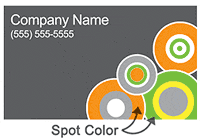Choosing the right paper stock or coating for your project is important to achieve the desired result.
What is uncoated paper?
All paper stocks start out being uncoated. Uncoated paper is porous with an uneven, rougher surface. As a result, uncoated paper is easier to write on as it absorb ink readily and dries to the touch faster. However, the heavier amount of ink uncoated paper absorbs may result in less rub resistance. Uncoated stocks include bonds, offsets, card, and newsprint.
What is coated paper?
After manufacture, the uncoated paper surface may be coated with white clay materials. The clay gives the paper a smooth feel by filling minute valleys in the paper surface. The coating also limits the absorption of inks into the paper. Because the inks stay on the surface of the coating instead of soaking in, the ink looks deeper, sharper and glossier. However, writing and ballpoint pen inks may take longer to dry on coated paper and can smudge more easily. On coated stock, less ink is need to achieve the desired visual richness for text, images and photo’s.
Coatings are offered in a range of reflectivity values including dull, matte, silk, satin or glossy. Reading long areas of text is easier when printed on dull or matt finishes. After printing images on dull or mat stock, a varnish can be applied to the picture areas to add gloss and make the pictures pop.
What’s the difference between coated and uncoated paper?
Paper with a coating is smooth and shiny while uncoated paper is flat with little or no shine. Gloss stock makes colors look smoother, deeper, richer, with great color-contrast. Photo’s and graphics tend to look better on gloss stock, while text heavy documents and artwork are often use matte stock.
Text is more easily read on paper with a matte finish. The softer looking dull surface of matte paper provides color contrast and clarity. Unlike glossy paper, matte stock is more forgiving of fingerprints, smudges and dust.
Uncoated paper is very absorbant, and ink dots will tend to spread outwards (i.e., dot gain), leading to a less precise and darker image than when printed on coated stock. A similar effect happens when a paper towel is placed on a spilled drop of coffee. The drop diameter increases and gets a ragged edge as the liquid spreads in the absorbant fibers. This dot gain can be minimized using sophisticated printing techniques, but it can’t be eliminated. Coated paper is less absorbant and therefore dot gain is usually not an issue.
What’s the difference between coated paper and a coating finish?
A coated paper is produced at the paper mill with a smooth surface and can have a range of reflectivity values including dull, matte, silk, satin or glossy. A coating finish on the other hand is a clear layer applied after the ink is printed on the paper. It is used to enhance the visual appeal of printed graphics or to add durability and protection to the printing.
What is uncoated finishing?
A protective coating or varnish will not be applied to the printed piece.
uncoated paper printed, no coating finish coated paper printed, no coating finish
What is coated finishing?
Coating finishes are applied after the ink. They are often used to enhance the appearance of graphics. These coatings also protect the printed surface from scratching, marring, fingerprints and dirt by increasing the rub and scuff resistance.
Coating finishes improve durability of the printed pieces during shipment through to the end use of items such as postcards, brochures, catalog covers, flyers. Coating finishes can also be used on enhance economy-grade paper by improving gloss and providing a smoother touch.
What is aqueous coating?
An aqueous coating is a water-based coating applied to a printed piece to enhance the graphics with a matte or gloss finish and to provide added durability and protection. Aqueous coatings provide good rub and scuff resistance. Like other finishes applied to printed paper, it protects the surface from scratches, fingerprints, dirt, and smudging.
What’s the difference between an aqueous coating and traditional varnish?
Aqueous coatings are less costly than varnish. Aqueous coatings are dried in minutes while a traditional varnishes may need a few hours or days to dry. Aqueous coatings don’t yellow with age while varnishes will yellow.
What’s the difference between an aqueous coating and UV coating?
Aqueous coatings are dried by hot air, UV coatings are almost instantly dried and cured by ultraviolet light. UV coatings are tougher and more slippery than aqueous. A ballpoint pen can be used to write on an aqueous coating, but not on most UV coatings. UV coatings can achieve a higher gloss.
What is UV coating finishing?
A matte, silk, satin or glossy finish is applied to the entire printed piece. For this type of coating a liquid is applied to the printed paper and exposed to an ultraviolet light which rapidly cures it and bonds it to the paper. UV coating adds durability to the printed piece and deters dirt. For most UV coatings, the piece can no longer be printed on nor written on with a ballpoint pen.
What is spot UV finishing?
A matte, silk, satin or glossy finish can be applied to specific “spot” areas of the printed piece such as photographs and graphic images. For this type of coating a liquid is applied to the printed paper and exposed to an ultraviolet light which rapidly cures it and bonds it to the paper.
C1S paper:Paper coated one side. Not to be confused with UV and aqueous coatings or laminates, the terms C1S and C2S refer to paper coated at the manufacturing stage, prior to printing. Coated paper has a smoother printing surface and lower ink absorption than uncoated paper. C1S is available for catalog covers and for our packaging products.

C2S paper:
Paper coated on two sides. Not to be confused with UV and aqueous coatings or laminates, the terms C1S and C2S refer to paper coated at the manufacturing stage, prior to printing. Coated paper has a smoother printing surface and lower ink absorption than uncoated paper.
Card Stock:
Also called cover stock. Mostly heavyweight papers are called cards stock. The thickness of card stock is indicated with point sizes such as 14pt, 16pt. Some people will also refer to 100lb gloss cover as a card stock.
Coating:
The mixture of clay materials that are applied to paper to improve the smoothness of the paper’s surface and improve ink holdout during the printing process. Examples are Aqueous coating (AQ) and UV coating. UV coating adds a gloss finish to the product and also improves the vibrancy of the printed colors. Spot-UV can be applied to selected portions of the piece, while keeping the rest a matte finish.
Foil:
The application of metallic gold or silver foil on paper using a heated die. The foil is adhered to the surface leaving the design of the die on the paper. Our Foil Stamp Printing adds a custom touch to your printed product by applying a thin film of metal to paper that creates a high grade, eye-catching result.
Gloss Finish:
A coating on paper that provides a higher reflection of light, which results in a shiny appearance. Gloss coatings reduce ink absorption, which allows excellent contrast and color definition.
Gloss Paper:
Paper with a gloss finish, usually used for higher quality printing. Examples are 100lb gloss book, and 100lb gloss cover.
Paper with a gloss finish, usually used for higher quality printing. Examples are 100lb gloss book, and 100lb gloss cover.
Lamination:
The process of applying a film, often plastic or copolymer, to either one or both sides of a printed sheet. Lamination adds a gloss or silk finish to a printed product and provides durability, water resistance and tear resistance.
Gloss Lamination: A high gloss film applied to one or both sides of a print product. Gloss lamination is optically clear, durable and is scuff, tear and water resistant.
Silk Lamination: A dull matte film applied to one or both sides of a print product. Silk lamination give cards a luxurious smooth feel and may dull color and contrast slightly. Durable Silk lamination is tear and water resistant.
Satin AQ
Our Satin AQ is a water-based aqueous coating that helps seal and protect the printed product and provides a luxurious, satin finish. Click here to view our Satin AQ Products
Spot Coating / Spot UV:
Coating paper only in specific areas as opposed to all over coating. In a Spot UV job the job gets a UV coating in only specific areas and does not get any AQ coating in any other places. Spot UV can be referred to as spot varnish.
Spot Color:
Printing with one or more solid colors, generally black ink is used with the addition of other colors. It is used to add highlight and add color to a printed product without having to print with four-color process.

UV Coating:
A liquid coating applied to the printed piece, which is then bonded and cured with ultraviolet light. This coating is used to provide a protective coating to the printed image. Please note that you CAN NOT write or imprint on a uv coated jobs
Varnish:
A thin, liquid protective coating, either matte or glossy, that is applied to the product. It adds protection and enhances the appearance of the product. It can be applied as an all over coating or it can be applied as a spot coating.

